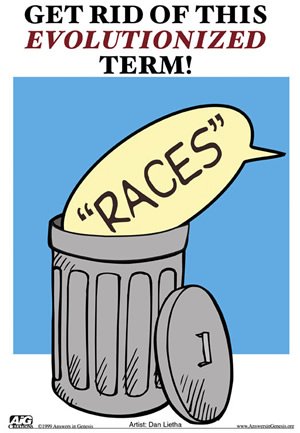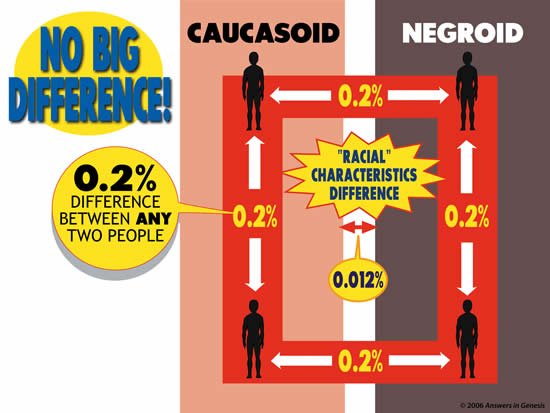In the 1800s, before Darwinian evolution was popularized, most people, when talking about “races,” would be referring to such groups as the “English race,” “Irish race,” and so on. However, this all changed in 1859 when Charles Darwin published his book On the Origin of Species by Means of Natural Selection or the Preservation of Favoured Races in the Struggle for Life.
Darwinian evolution was (and still is) inherently a racist philosophy, teaching that different groups or “races” of people evolved at different times and rates, so some groups are more like their apelike ancestors than others. Leading evolutionist Stephen Jay Gould claimed, “Biological arguments for racism may have been common before 1859, but they increased by orders of magnitude following the acceptance of evolutionary theory.”
The Australian Aborigines, for instance, were considered the missing links between the apelike ancestor and the rest of mankind. This resulted in terrible prejudices and injustices towards the Australian Aborigines.
Ernst Haeckel, famous for popularizing the now-discredited idea that “ontogeny recapitulates phylogeny,” stated:
At the lowest stage of human mental development are the Australians, some tribes of the Polynesians, and the Bushmen, Hottentots, and some of the Negro tribes. Nothing, however, is perhaps more remarkable in this respect, than that some of the wildest tribes in southern Asia and eastern Africa have no trace whatever of the first foundations of all human civilization, of family life, and marriage. They live together in herds, like apes.
Racist attitudes fueled by evolutionary thinking were largely responsible for an African pygmy being displayed, along with an orangutan, in a cage in the Bronx zoo. Indeed, Congo pygmies were once thought to be “small apelike, elfish creatures” that “exhibit many ape-like features in their bodies.”
As a result of Darwinian evolution, many people started thinking in terms of the different people groups around the world representing different “races,” but within the context of evolutionary philosophy. This has resulted in many people today, consciously or unconsciously, having ingrained prejudices against certain other groups of people.
Scientists today admit that, biologically, there really is only one race of humans.
However, all human beings in the world today are classified as Homo sapiens sapiens. Scientists today admit that, biologically, there really is only one race of humans. For instance, a scientist at the Advancement of Science Convention in Atlanta stated, “Race is a social construct derived mainly from perceptions conditioned by events of recorded history, and it has no basic biological reality.” This person went on to say, “Curiously enough, the idea comes very close to being of American manufacture.”

Reporting on research conducted on the concept of race, ABC News stated, “More and more scientists find that the differences that set us apart are cultural, not racial. Some even say that the word race should be abandoned because it’s meaningless.” The article went on to say that “we accept the idea of race because it’s a convenient way of putting people into broad categories, frequently to suppress them—the most hideous example was provided by Hitler’s Germany. And racial prejudice remains common throughout the world.”
In an article in the Journal of Counseling and Development, researchers argued that the term “race” is basically so meaningless that it should be discarded.
More recently, those working on mapping the human genome announced “that they had put together a draft of the entire sequence of the human genome, and the researchers had unanimously declared, there is only one race—the human race.”
Personally, because of the influences of Darwinian evolution and the resulting prejudices, I believe everyone (and especially Christians) should abandon the term “race(s).” We could refer instead to the different “people groups” around the world.
The Bible and “Race”
The Bible does not even use the word race in reference to people, but it does describe all human beings as being of “one blood” (Acts 17:26). This of course emphasizes that we are all related, as all humans are descendants of the first man, Adam (1 Corinthians 15:45), who was created in the image of God (Genesis 1:26–27). The Last Adam, Jesus Christ (1 Corinthians 15:45) also became a descendant of Adam. Any descendant of Adam can be saved because our mutual relative by blood (Jesus Christ) died and rose again. This is why the gospel can (and should) be preached to all tribes and nations.
Can the Bible be used to justify racist atitudes?
The inevitable question arises, “If the Bible teaches all humans are the same, where was the church during the eras of slavery and segregation? Doesn’t the Bible actually condone the enslavement of a human being by another?”
Both the Old and New Testaments of the Bible mention slaves and slavery. As with all other biblical passages, these must be understood in their grammatical-historical context.
Dr. Walter Kaiser, former president of Gordon-Conwell Theological Seminary and Old Testament scholar, states:
The laws concerning slavery in the Old Testament appear to function to moderate a practice that worked as a means of loaning money for Jewish people to one another or for handling the problem of the prisoners of war. Nowhere was the institution of slavery as such condemned; but then, neither did it have anything like the connotations it grew to have during the days of those who traded human life as if it were a mere commodity for sale. . . . In all cases the institution was closely watched and divine judgment was declared by the prophets and others for all abuses they spotted.
Job recognized that all were equal before God, and all should be treated as image-bearers of the Creator.
If I have despised the cause of my male or female servant when they complained against me, what then shall I do when God rises up? When He punishes, how shall I answer Him? Did not He who made me in the womb make them? Did not the same One fashion us in the womb? (Job 31:13–15)
In commenting on Paul’s remarks to the slaves in his epistles, Peter H. Davids writes:
The church never adopted a rule that converts had to give up their slaves. Christians were not under law but under grace. Yet we read in the literature of the second century and later of many masters who upon their conversion freed their slaves. The reality stands that it is difficult to call a person a slave during the week and treat them like a brother or sister in the church. Sooner or later the implications of the kingdom they experienced in church seeped into the behavior of the masters during the week. Paul did in the end create a revolution, not one from without, but one from within, in which a changed heart produced changed behavior and through that in the end brought about social change. This change happened wherever the kingdom of God was expressed through the church, so the world could see that faith in Christ really was a transformation of the whole person.
The forced enslavement of another human being goes against the biblical teaching that all humans were created in the image of God and are of equal standing before Him.
Those consistently living out their Christian faith realize that the forced enslavement of another human being goes against the biblical teaching that all humans were created in the image of God and are of equal standing before Him (Galatians 3:28; Colossians 3:11). Indeed, the most ardent abolitionists during the past centuries were Bible-believing Christians. John Wesley, Granville Sharp, William Wilberforce, Jonathan Edwards, Jr., and Thomas Clarkson all preached against the evils of slavery and worked to bring about the abolition of the slave trade in England and North America. Harriet Beecher Stowe conveyed this message in her famous novel Uncle Tom’s Cabin. And of course, who can forget the change in the most famous of slave traders? John Newton, writer of “Amazing Grace,” eventually became an abolitionist after his conversion to Christianity, when he embraced the truth of Scripture.
“Racial” Differences
But some people think there must be different races of people because there appear to be major differences between various groups, such as skin color and eye shape.
The truth . . . is that these so-called “racial characteristics” are only minor variations among people groups.
The truth, though, is that these so-called “racial characteristics” are only minor variations among people groups. If one were to take any two people anywhere in the world, scientists have found that the basic genetic differences between these two people would typically be around 0.2 percent—even if they came from the same people group. But these so-called “racial” characteristics that people think are major differences (skin color, eye shape, etc.) “account for only 0.012 percent of human biological variation.”
Dr. Harold Page Freeman, chief executive, president, and director of surgery at North General Hospital in Manhattan, reiterates, “If you ask what percentage of your genes is reflected in your external appearance, the basis by which we talk about race, the answer seems to be in the range of 0.01 percent.”
In other words, the so-called “racial” differences are absolutely trivial— overall, there is more variation within any group than there is between one group and another. If a white person is looking for a tissue match for an organ transplant, for instance, the best match may come from a black person, and vice versa. ABC News claims, “What the facts show is that there are differences among us, but they stem from culture, not race.”

The only reason many people think these differences are major is because they’ve been brought up in a culture that has taught them to see the differences this way. Dr. Douglas C. Wallace, professor of molecular genetics at Emory University School of Medicine in Atlanta, stated, “The criteria that people use for race are based entirely on external features that we are programmed to recognize.”
If the Bible teaches and science confirms that all are of the same human race and all are related as descendants of Adam, then why are there such seemingly great differences between us (for example, in skin color)? The answer, again, comes with a biblically informed understanding of science.
Resources: AnswersinGenisis
